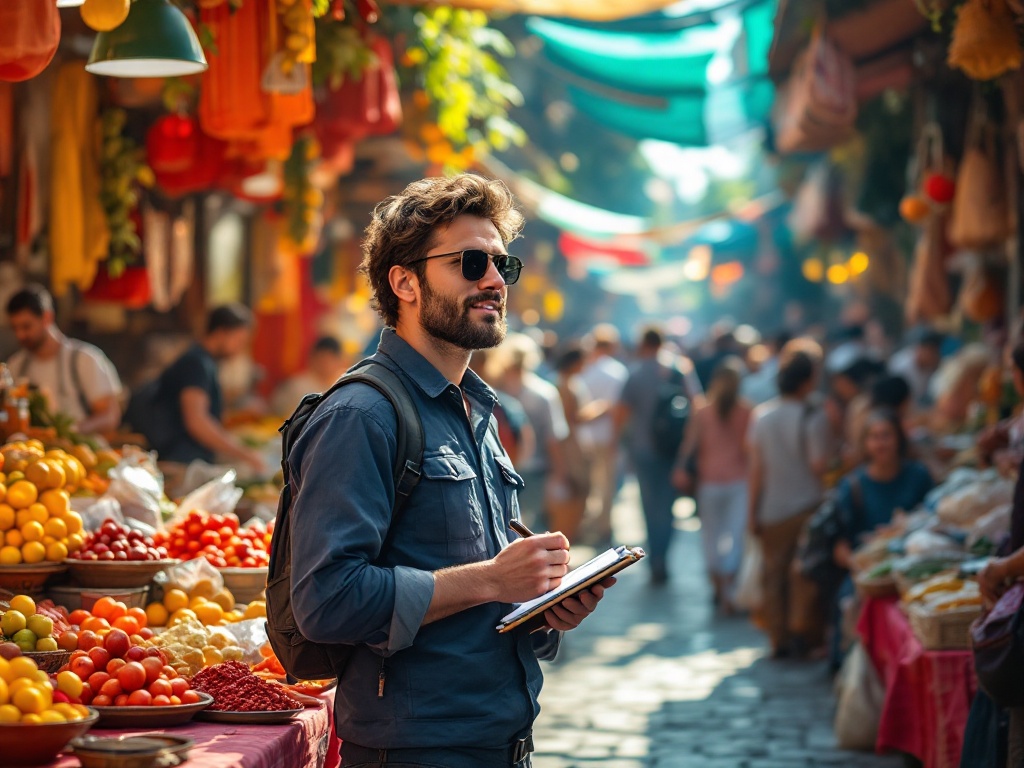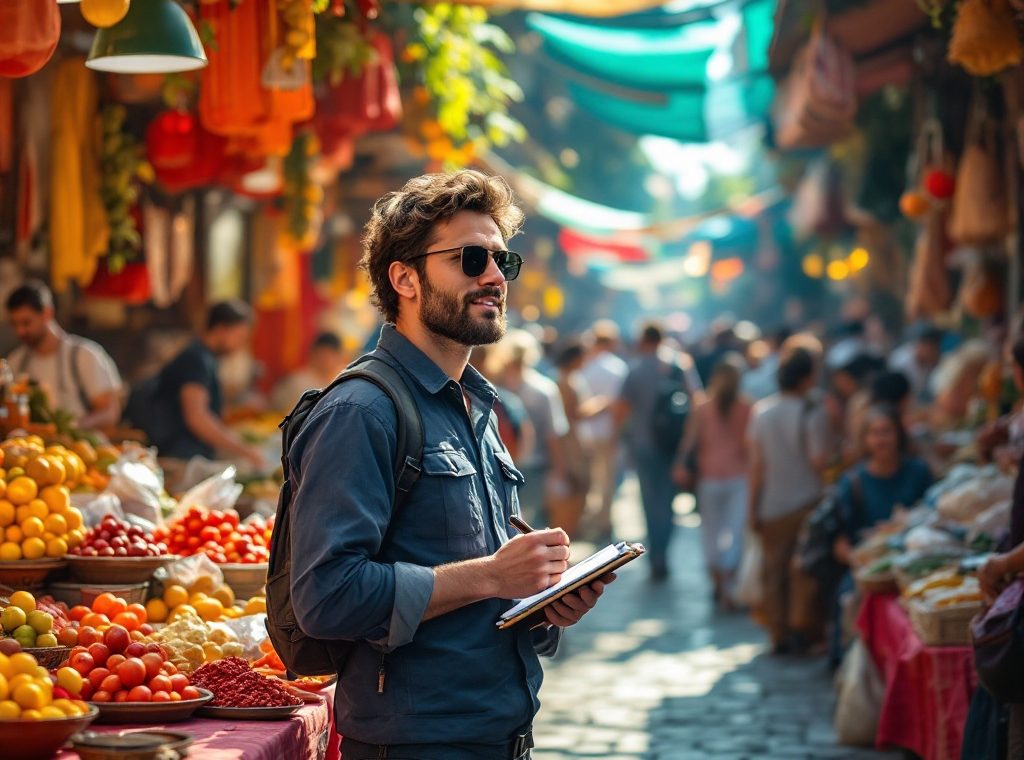How to Write like a Travel Journalist?
Dream of a career exploring exotic locales and sharing your adventures? Travel journalism offers an exciting path, but it demands more than a love for travel. This comprehensive guide delves into the realities of this profession, from mastering vivid storytelling and multimedia integration to navigating the financial hurdles and unconventional work hours. Discover the essential skills, educational paths, and networking strategies to thrive in this competitive field. Start your journey toward becoming a successful travel journalist today!
Important information

- Travel journalists conduct in-depth research, going beyond tourist hotspots to explore local customs and hidden gems, conveying these experiences through vivid writing.
- Success requires adaptability to unconventional hours and unpredictable costs, along with persistence, patience, resourcefulness, and independence.
- A strong portfolio is essential, often built through a travel blog and contributions to travel magazines, incorporating multimedia like photos and videos.
- Effective pitching involves a captivating headline, unique angle, clear structure, understanding of the target audience, and an explanation of the story’s timeliness (“Why now?”).
- Networking is crucial, connecting with editors, tourism boards, fellow writers, and other industry professionals for opportunities and support.
Understanding the Role of a Travel Journalist
Travel journalists traverse the globe, offering unique insights into diverse cultures and captivating destinations. Their work necessitates meticulous research, emphasizing accuracy and in-depth exploration. Venturing beyond typical tourist hotspots, they uncover local customs and hidden gems, immersing themselves in bustling markets or experiencing traditional festivals. Through vivid descriptions, they transport readers, evoking a strong sense of place and inspiring wanderlust. This career, however, demands adaptability, with unconventional hours and unpredictable expenses. Persistence and patience are essential for navigating these challenges and building a thriving career. It’s not a typical 9-to-5 job but a vocation requiring constant effort and flexibility. Resourcefulness and independence are also crucial for success in this exciting field.
Responsibilities of a Travel Journalist
- meticulous research, prioritizing accuracy and in-depth exploration,
- venturing beyond typical tourist attractions to unearth local customs and hidden gems,
- transporting readers through vivid descriptions, evoking a sense of place,
- adapting to unconventional hours and unpredictable expenses.
Essential Qualities for Success
- persistence and patience,
- constant effort and flexibility,
- resourcefulness and independence.
Essential Skills for Travel Writing
Travel writing demands a diverse skillset. Writers must balance meticulous research with evocative prose, often incorporating visuals like photos and videos. The goal is to transport readers, immersing them in another place through vivid descriptions and compelling narratives. Rich details bring a destination to life, while local insights add depth and authenticity. Thorough research is essential for accuracy and uncovering hidden gems. However, facts alone are insufficient; skilled travel writers weave these elements into captivating stories. For example, they might describe Marrakech’s bustling marketplace, capturing the scent of spices and the explosion of colors, creating an immersive experience that connects readers with the destination.
Developing a Unique Voice and Writing Style
Travel journalists don’t just recount their adventures, they craft compelling stories that captivate readers. A unique voice is essential in this competitive field. To find yours, explore diverse travel writing styles and tones. Authenticity is key; embrace your individual perspective and experiences. Regular practice and feedback are vital to refine your voice and develop a signature style.
Mastering Descriptive Language and Storytelling
Descriptive language uses carefully chosen words to create vivid sensory experiences, like the aroma of exotic spices or the warmth of the sun. Strong storytelling is also essential, drawing readers in with narratives that have a clear beginning, middle, and end. Skilled travel writers combine these elements, transporting us to distant lands where we encounter new cultures and forge lasting memories.
Conducting Thorough Research and Validating Ideas
Thorough research forms the foundation of accurate and respectful travel writing, ensuring factual accuracy and promoting cultural sensitivity. By verifying information against reliable sources, writers establish credibility and create authentic narratives. This multifaceted process involves exploring diverse perspectives and meticulous fact-checking, ultimately crafting captivating stories that resonate with readers. This involves:
- Consult a variety of sources, including local experts, guidebooks, and reputable websites, to gain a comprehensive understanding of your destination.
- Engage with diverse voices and perspectives to ensure a balanced representation of the local culture.
- Verify all information, including historical facts, cultural practices, and current events, against reliable sources to ensure accuracy.
- Fact-check everything, even seemingly minor details, to maintain credibility and avoid misrepresentation.
- Be mindful of potential biases in your sources and seek out multiple viewpoints to present a nuanced perspective.
- Respect local customs and traditions, and avoid perpetuating stereotypes or making generalizations.
- Prioritize sensitivity and accuracy when writing about sensitive topics, such as religion, politics, or social issues.
- Strive to create authentic narratives that capture the essence of the destination and resonate with readers.
Balancing Multiple Responsibilities as a Travel Writer
Travel writers are multi-talented individuals, juggling research, photography, writing, and social media management. Balancing destination research with compelling content creation requires excellent time management and organization, especially for meeting deadlines and staying productive. They also manage their finances, from trip expenses to freelance payments. Networking with editors, tourism boards, and fellow writers is essential for career growth. Finally, adaptability is crucial, as travel plans can change unexpectedly, demanding flexibility. Travel writers possess a diverse skillset:
- research,
- photography,
- writing,
- social media management.
Effective time management and organization are essential for balancing research with content creation, meeting deadlines, and maintaining productivity. Financial management is also key, encompassing trip expenses and freelance payments. Networking with editors, tourism boards, and other writers is crucial for career advancement. Adaptability is vital, as unexpected changes in travel plans require flexibility.
Educational Paths to Travel Journalism
A journalism degree provides a solid foundation in writing, reporting, and ethics, making it beneficial for aspiring travel journalists.
Online courses and workshops offer targeted training in travel writing, photography, and multimedia storytelling, ideal for career changers or supplementing formal education.
Mentorship programs connect aspiring writers with seasoned professionals.
These programs offer personalized guidance and industry insights, helping navigate the field and build essential connections.
The Value of Formal Education and Training
Aspiring travel writers can benefit from a formal education in fields like journalism or communications. These programs hone essential skills, from writing techniques and research methods to the art of storytelling. Students also receive crucial feedback, refining their writing and grasping important concepts like media law and ethics. A structured learning environment offers several advantages:
- Skill development: formal programs enhance writing, research, and storytelling abilities,
- Constructive criticism: students receive valuable feedback to refine their craft,
- Ethical grounding: programs cover media law, ethics, and responsible reporting.
Benefits of Online Courses and Workshops
Enhance your travel writing skills with online courses and workshops designed for flexible learning. Study at your own pace and explore key topics such as crafting compelling stories, optimizing content for search engines, and navigating the world of freelance writing. These programs provide practical skills applicable to diverse formats, including blog posts, articles, and social media content. Receive valuable feedback from experienced travel writers to refine your work and elevate your writing.
Importance of Mentorship in Travel Writing
A mentor can significantly boost the career of aspiring travel writers by providing valuable insights and guidance in the dynamic field of travel journalism. Experienced mentors offer essential support and encouragement, helping writers gain confidence and polish their skills. They share their expertise on various aspects of the craft, including storytelling techniques, effective research strategies, and successful pitching methods. Mentors can also broaden a writer’s professional network by connecting them with industry professionals and opening doors to exciting opportunities. This support nurtures growth, hones writing skills, and enables writers to build successful careers in travel journalism.
Building a Successful Travel Writing Portfolio
A travel blog offers a fantastic platform to showcase your writing and develop a compelling portfolio, allowing you to experiment with various styles and discover your unique voice. Creating high-quality content for travel magazines is equally crucial, demonstrating your ability to write for a target audience while adhering to editorial guidelines. Incorporating multimedia, such as photography and video, can further enrich your content and attract a broader viewership. Strong writing remains fundamental, even with these enhancements. Combining these efforts cultivates a diverse portfolio, strengthening your credentials and making you a more sought-after writer.
Starting a Travel Blog to Showcase Skills
A travel blog offers a fantastic platform to showcase your writing talents, build a portfolio, and share your exciting adventures with the world. It’s a powerful tool to attract potential clients and publishers. Moreover, blogging allows you to experiment with various writing styles and engage directly with your audience, demonstrating your travel writing expertise.
Creating High-Quality Content for Travel Magazines
Captivating travel writing blends vivid storytelling, rich detail, and practical advice. Accuracy, built on thorough research and fact-checking, is crucial for reader trust. A fresh perspective, enhanced by stunning visuals, immerses the audience in the destination. Tailoring content to your audience amplifies its impact.
Backpacking through Southeast Asia
Requires a different tone and focuses on budget-friendly tips, adventurous experiences, and cultural immersion.
Reviewing a luxury cruise
Emphasizes high-end amenities, personalized service, and exclusive destinations, appealing to a different type of traveler.
Strong visuals and accurate information benefit both backpacking and luxury travel content. Adhering to a magazine’s style guide ensures a seamless fit. Compelling travel content transports readers, inspiring them to explore the world.
Integrating Multimedia Skills into Travel Writing
Photos and videos breathe life into travel stories, offering immersive glimpses of distant lands.
Interactive maps empower readers to visually explore destinations, charting their own course for adventure.
Drones provide a unique vantage point, capturing breathtaking aerial perspectives.
Podcasts and audio recordings add another dimension, capturing the vibrant sounds of bustling markets and local chatter.
Social media fosters real-time connection, enabling the sharing of updates and engagement with followers.
These tools ultimately enrich travel storytelling, offering diverse perspectives and creating truly captivating content.
Pitching Techniques for Travel Journalists
Crafting a winning pitch for travel journalists requires a clear structure, a fresh perspective, and impeccable timing.
Key Elements of a Successful Pitch
- Start with a captivating headline that immediately grabs the editor’s attention.
- Provide a concise summary of your story idea.
- Suggest a unique angle that sets your piece apart.
- Outline potential sources and visuals to strengthen your proposal.
- Specify your target audience and intended word count.
- Include your credentials and contact information.
Making Your Story Stand Out
A unique angle is crucial. Focus on a specific aspect of your destination, such as an unusual activity, a local tradition, or a personal anecdote. This fresh perspective distinguishes your work from generic travel articles. It appeals to a niche audience and answers the question: “What makes this story different?”.
Headline
Start with a captivating headline that immediately grabs the editor’s attention.
Summary
Provide a concise summary of your story idea.
Unique Angle
Suggest a unique angle that sets your piece apart. For instance, focus on a specific aspect of your destination like an unusual activity, local tradition, or a personal anecdote.
Supporting Materials
Outline potential sources and visuals to add depth and credibility to your proposal.
Target Audience and Length
Specify your target audience and intended word count to demonstrate your understanding of the publication’s readership.
Credentials and Contact
Include your credentials and contact information so the editor can easily reach you.
Timing is crucial. Your pitch must address the “Why now?” question, justifying the story’s current relevance. Upcoming events, seasonal changes, or recent news can provide timely hooks. Explaining this immediacy increases your chances of acceptance, showing the editor why this story matters now.
Understanding the Structure of a Pitch
A captivating hook instantly grabs the reader. A clear, often outlined structure provides a roadmap. The core ISG paragraph details the Idea, Style, and Goal, illuminating the story’s potential and showcasing why this travel narrative deserves attention.
Highlighting the Unique Angle of Your Story
A unique angle is crucial for a captivating travel story. It’s the hook that catches an editor’s attention. Consider what distinguished your journey. Did you prioritize sustainable practices, conquer a personal obstacle, or immerse yourself in a unique cultural experience? Researching current travel trends can also inspire fresh perspectives. Perhaps you explored an under-reported region? Such unique experiences strengthen your pitch. Here’s how to find your unique angle:
Reflect on your journey. What made it memorable? What challenges did you overcome? What lessons did you learn? Pinpointing these elements can reveal your unique story.
Embrace the unexpected. Did you stumble upon a hidden gem? Did a chance encounter change your perspective? Often, the most compelling stories arise from unplanned moments.
Research travel trends. What topics are currently resonating with readers? What destinations are gaining popularity? Understanding these trends can help you position your story.
Consider your audience. Who are you writing for? What are their interests? Tailoring your story to a specific audience can make it more engaging.
Craft a compelling narrative. Once you have your angle, weave it into a captivating story with vivid descriptions and engaging details. Let your unique voice shine through.
Answering the ‘Why Now?’ Question in Your Pitch
Does your story connect with current events? Is it related to an upcoming event or a seasonal theme? Editors value timely narratives. Highlight your story’s relevance to current trends or recent developments to increase your chances of publication. Does a recent discovery or upcoming event make your piece especially important now? A seasonal angle can also enhance its newsworthiness. Demonstrating your story’s timeliness and explaining its immediate importance significantly improves its publication prospects.
Why Timeliness Matters
Editors prioritize stories that resonate with current events, upcoming occasions, or seasonal themes. Emphasizing the immediacy of your narrative increases its publication potential.
Highlighting Relevance
Explain how your story connects to current trends, recent developments, new discoveries, or upcoming events. A seasonal perspective can also strengthen its newsworthiness.
Connect your story to current events. Consider how your narrative relates to recent happenings or ongoing trends.
Link your story to upcoming events or seasonal themes. Timely narratives are often prioritized by editors.
Emphasize your story’s immediacy. Explain why your piece demands immediate attention.
Highlight the relevance to current trends or recent developments. Explain any connections to new discoveries or upcoming events.
Consider a seasonal perspective. A seasonal angle can add to your story’s newsworthiness.
Networking and Industry Engagement
Networking is essential for travel journalists, opening doors to exciting opportunities and collaborations. A strong network can spark fresh story ideas and connect you with industry experts. Building relationships with tourism boards and travel agencies offers valuable insights and access to destinations. Connecting with fellow journalists provides unique perspectives and support. Industry conferences and professional organizations, like the Society of American Travel Writers (SATW), are excellent networking hubs. Active online engagement within travel communities and on social media platforms can further enhance your credibility and reach. Cultivate your network and watch your career thrive.
Creating Impactful Travel Stories
Transport your readers with compelling travel stories that immerse them in the destination. Achieving this requires tapping into local knowledge. Researching customs, traditions, and uncovering hidden gems adds depth and authenticity to your narratives. Interviewing locals offers invaluable perspectives, enriching your stories with their unique insights. Vivid descriptions are equally crucial. Capture the environment’s sights, sounds, smells, and tastes to create a strong sense of place. By painting a vivid picture, you ignite readers’ desire to explore and experience the destination firsthand. They crave immersive experiences, yearning to connect with the place you describe.
Incorporating Local Knowledge for Depth
Local knowledge breathes life into travel writing, adding authenticity and depth that bypasses typical tourist traps. Thorough research is crucial, uncovering local customs and traditions and revealing hidden gems. Interviews with residents offer invaluable insights, collecting their unique stories and perspectives to forge genuine connections with both the place and its people. This connection enriches your writing, making it compelling and meaningful by sharing richer experiences with your audience. You move beyond superficial observations to reveal a deeper, more authentic understanding of your destination. Here’s how to achieve this:
Embrace Local Knowledge. Seek out local customs and traditions. Discover those hidden gems often missed by the average tourist.
Conduct Thorough Research. Deep dive into the history and culture of your destination. Unearth unique details that add depth to your writing.
Engage with Locals. Conduct interviews with residents. Gather their unique stories and perspectives to build genuine connections.
Transporting Readers with a Sense of Place
Transport your readers by immersing them in the atmosphere of a new place. Vivid descriptions engaging all their senses—sights, sounds, and even smells—will bring the location to life. Evocative imagery paints a powerful picture, allowing readers to experience the destination alongside you, forging a deeper connection.
Local customs and traditions add depth and authenticity, revealing the unique character of a place. Imagine describing a bustling market or a quiet village ritual. Focus on the nuances that make the destination special.
Avoid overwhelming the reader with excessive detail. Strive for a balance between rich description and a clear narrative. Strong descriptions transport readers, allowing them to not only experience the journey but also truly understand the destination.
Challenges and Realities of Travel Writing
Financial challenges are a common hurdle for aspiring travel writers. Costs accumulate rapidly, from visa applications and vaccinations to travel insurance and equipment upgrades. Pre-trip research and marketing also require investment, while income remains unpredictable, making financial management a constant challenge. Fluctuating exchange rates add further complexity.The workload can be demanding. Non-traditional hours, including weekends and holidays, are often necessary to meet deadlines across time zones. Building a successful career requires persistent pitching, strategic networking, and adaptability in this dynamic industry. Rejection and slow responses are unavoidable, and establishing a reputation and securing consistent work demands time and patience.
Understanding the Hidden Costs and Non-Traditional Work Hours
Travel journalists face numerous expenses beyond the basic travel costs. These include visas, vaccinations, and insurance. Maintaining and upgrading essential equipment like cameras and laptops is an ongoing cost, along with software subscriptions. The unpredictable work schedule often extends beyond traditional hours, requiring flexibility for early mornings, late nights, and weekend assignments. Managing deadlines across multiple time zones necessitates strong time management skills.
Expenses
- visas,
- vaccinations,
- insurance.
Equipment and Software
- cameras,
- laptops,
- software subscriptions.
The unpredictable work schedule often involves early mornings, late nights, and weekend assignments. Managing deadlines across multiple time zones demands considerable flexibility and strong time management skills.
Persistence and Patience in Building a Career
Breaking into travel writing is a challenging but rewarding pursuit. It demands persistence and patience, as building a reputation takes time and dedication. Rejections are inevitable, and income can fluctuate, so resilience is key. Developing a strong portfolio and professional network requires significant effort, but a long-term vision can pave the way to success. These hurdles are simply part of the journey. The following steps can help you navigate the path:
Hone your writing skills. Practice consistently and seek feedback to improve your craft. Focus on developing a unique voice and perspective.
Build a strong portfolio. Start a blog or contribute to online platforms to showcase your work. Diversify your writing samples to demonstrate your versatility.
Network with other travel writers and editors. Attend industry events, join online communities, and build relationships with professionals in the field. Networking can open doors to opportunities and collaborations.
Pitch your ideas to publications. Research target markets and tailor your pitches accordingly. Persistence is key, as rejections are common. Learn from each experience and refine your approach.
Embrace the journey. Travel writing can be a challenging but rewarding career path. Embrace the challenges and celebrate your successes along the way.













